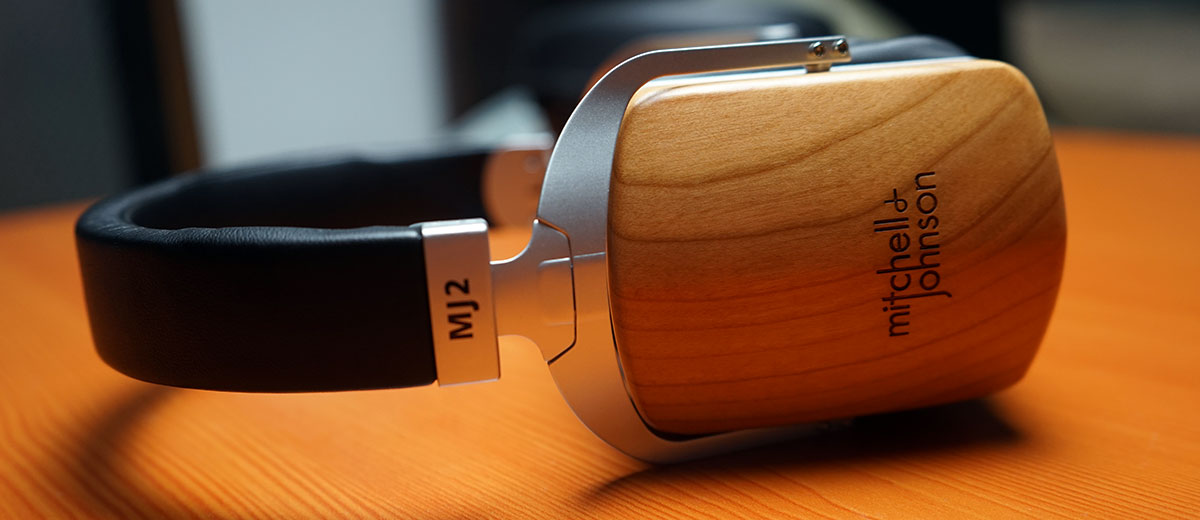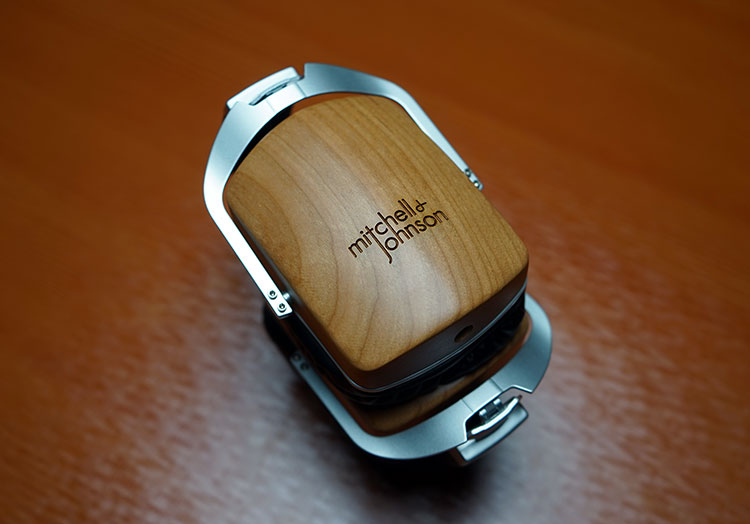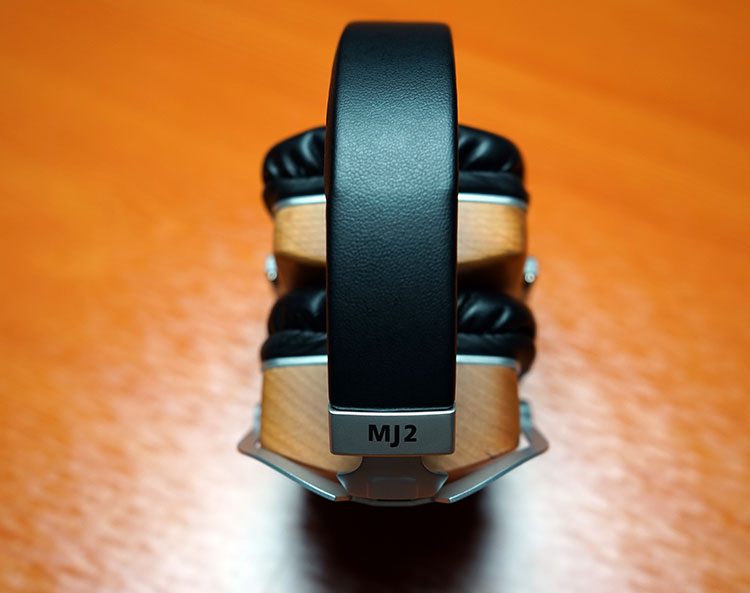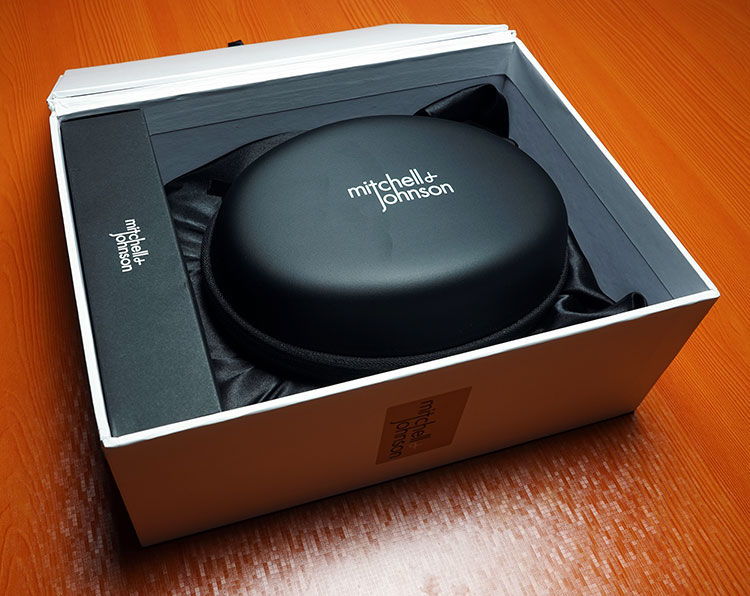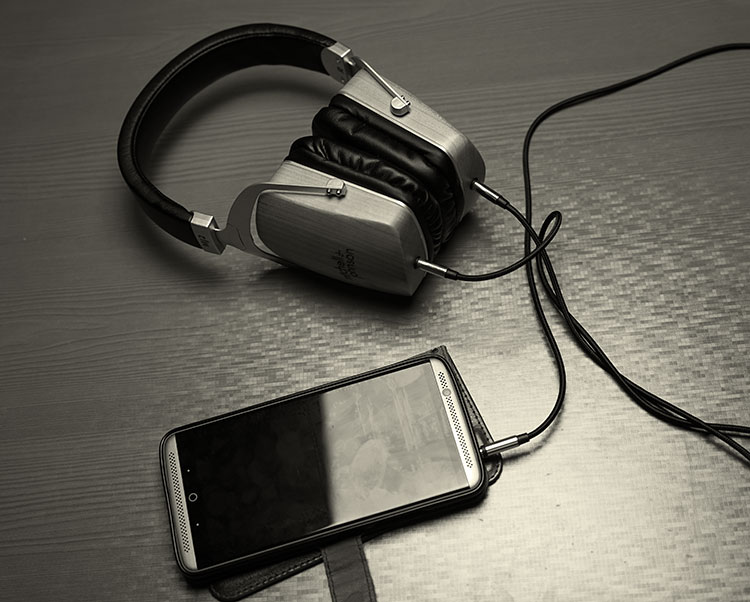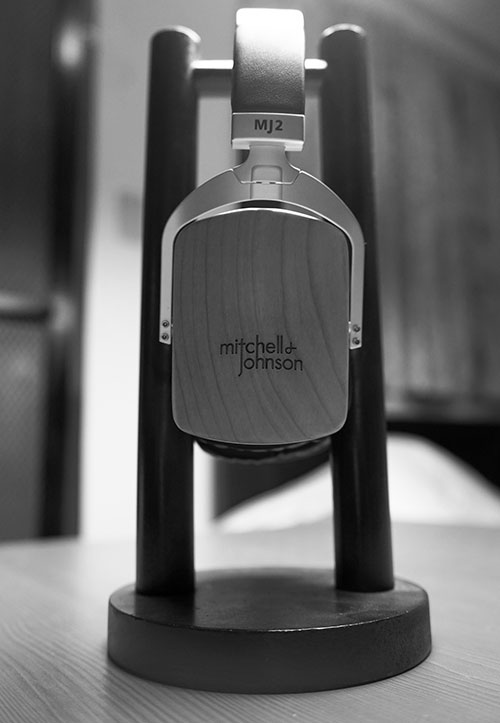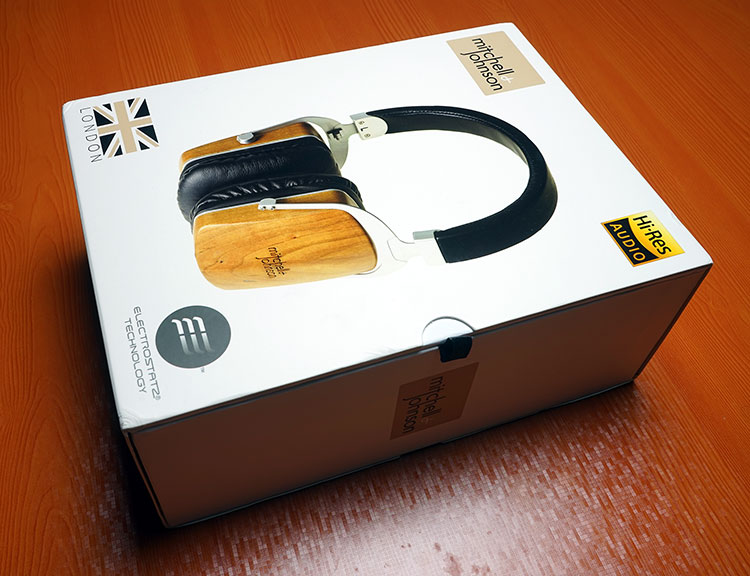The Mitchell & Johnson MJ2 is a new closed-back wood design based on an electret and dynamic driver hybrid configuration. It is priced at £499.99.
Disclaimer: The Mitchell & Johnson MJ2 was sent to us as a sample in exchange for our honest opinion in this review. We thank Mitchell & Johnson for this opportunity.
To learn more about headphones reviewed on Headfonics you can click here.
Note, this review follows our new scoring guidelines for 2020 which you can read up on here.
The MJ2 came to me by way of an industry recommendation to try out their new line of “Electrostatz” headphones recently launched under the Mitchell & Johnson brand for $499.99 and sporting some interesting designs cue using a healthy mix of wood and steel.
For those not familiar with the name technically Mitchell & Johnson invested into the original designer of the MJ2, Verisonix, and previously the MJ2 was known as the N501.
I am not quite sure if anything has changed other than the branding given the specs and contents look largely the same but for sure the M&J network will give this unique headphone a much bigger platform and distributing network opportunity for more people to hear it.
What Is The Pitch?
Old School, New School
And hear it they should because of the hybrid technology it uses which will give you a taste of that electrostatic sound without the need for an electrostatic amp. How is that possible without an amp? Well, technically the MJ2 is what they call an electret headphone.
This is old school new school technology in many ways because AKG tried it with their AK340 many years ago but since dropped the concept and only recently, with the Enigma Dharma headphone, have we seen the return of this concept.
Electret drivers
An electret driver pretty much operates on the same principle as an electrostatic driver except rather than receive a charge via an amp the electret driver is permanently charged using a special diaphragm that can store and utilize this charge in everyday use.
Built-in tiny step-up transformers are the key to allowing electrets work from normal voltage amps typically used by dynamic and planar headphones and break free from the electrostatic amp setup.
Hi-Res
In years gone by, electret headphones were seen as the poor man’s stats, and to be truthful quite a few of them failed to make the mark quality-wise as well as requiring fairly powerful amps.
What is interesting in the MJ2 pitch is that this particular headphone has been deemed to be of high enough quality to have attained the Japan Audio Society’s seal of approval, hence the “Hi-Res” audio sticker you will see on the front of the box.
Portability
The MJ2 is also pitched to the mobile user, more so than the Dharma. It is closed, foldable, and quite compact and its ratings make it fairly easy to drive. For those who want a taste of what stats can do or a high-quality electret then the MJ2’s mid-fi price point and general all-round mobility may well place it in an entirely unique position in the market today.
Design
Closed
The hybrid MJ2 is a closed large supraaural headphone designed for portable and home use. It contains a single electret driver and a more traditional 40mm dynamic driver in each cup. It is a dual cup detachable build with an inward folding mechanism that enables the MJ2 to fold nice and neat into a small carry case although they are not designed to swivel or to fold flat.
Wood
The cups are carved out of an attractive and light-colored and rectangular-shaped cherry wood enclosure. The grain is actually very well done, nothing too asymmetrical or knot-riven with smooth cornering and a healthy dose of protective lacquer. It is unlikely you will see these cups split even in humid conditions.
The Mitchell & Johnson logo is elegantly etched right into the wood on the front of the cups. Despite the cups having a fairly thick looking physical appearance they are fairly light in the hand also adding to the portability appeal of this headphone.
Gimbals
The MJ2 gimbals are made from a lightweight metal alloy held firmly in place with 4 tiny screws (2 a side) and flow into a headband design very similar to that of the Oppo PM series with its uniband structure, simple leatherette covering, and lightweight padding underneath the leatherette materials.
The gimbal movement is fluid and thankfully creak free given this is one of the major selling points being able to fold the MJ2.
Headband
The headband itself is not 100% rigid, there is a degree of flex there to comfortable fit and shape around different head sizes. The headband is adjustable on notched sliders either side. Though there is not a huge amount of bite in the notches I can’t see them accidentally sliding during use; they seem to stay fairly well in place.
Comfort & Fit
The MJ2 uses a leatherette rectangular-shaped set of pads that are reasonably soft and comfortable as well as giving a good seal around the ear. They do sit more on your ear hence I would classify them as supraaural in design.
They are not quite as isolating as Oppo’s PM series pads nor are they as deep as MrSpeakers lambskin pads but they are superior to Meze’s 99 Classic MK1 one pads which are thinner and not quite as comfortable. The passive isolation on the pads though is pretty good for a decent closed on-ear headphone system.
Comfort-wise the clamp is good, not overly cooked or too loose. Pressure distribution is not 100% even though this may depend on your head shape and size.
For my head, there is a small amount of dominant downward pressure over sideways clamping pressure which has the effect of that “about to slide down” feeling on the cups. There is a single pressure point on the top of the headband that is fairly focused for me also rather than spread over the scalp.
Cables
Or should I say cable? From what I gather the N501 (previous edition under Verisonix) did come with 2 cables; one short and one long. Now the feedback was not so hot on the long one and it seems to have been dropped from the MJ2 package. If anything, this makes the MJ2 almost 100% for portability since the short one is, well, rather short.
It is though a well-made cable with a high-quality woven cloth finish, rock-solid strain relief, and a tank-like y-split. The terminations are a 3.5mm stereo gold plated straight plug at one end and a dual entry 3.5mm TRS jack system for attaching to the Mj2 at the base of the cups.
The cables are bi-directional, there are no l/r labels on the connectors, just pop them in any way you like and it will take the signal in the right manner. That is a boon for late-night low-lit conditions and saves a lot of time fiddling to find which is which. The cups themselves are clearly labeled left and right so you will not mix that up when putting them on.
Accessories & Packaging
The physical presentation is well thought out, attractive, and professional looking. You do not get the Mj2 wrapped in a mix of crude plastic and cardboard.
Opening up the fairly a sturdy box you get presented with a compact semi-stiffened zipper case holding the headphones themselves on top of a presentation satin cloth bed. Inside you receive the detachable short nylon cable, a gold plated quarter jack adapter as well as an additional airline adapter as a further nod to the portability scenarios for the MJ2.
Shy of a second cable or some sort of fold-out headphone stand (MrSpeakers Alpha Dogs style) most of the bases for a headphone package are covered.
Sound Impressions
Tonality & Presentation
Apart from a minor lift in the low-end throwing over a very tiny element of warmth the MJ2 has a neutral and tight presentation. It is also an incredibly controlled and quick-paced presentation as you would expect from that charged little electret driver.
If you are coming from a purely electrostatic driver experience there are some similarities particularly in the level of mid to treble detail and that lovely sparkle that’s incredibly sibilant free. The top-end extension is outstanding yet never strikes me as overly forward or harsh. Vocals are neutral but controlled and accurate sounding and imaging is really pinpoint even if the staging is not the most expansive.
Effortless
It is that effortless presentation and clarity that always gets me with stats presentations. You get the detail, you get the incredible articulation but it never feels forced and “driven”.
Those looking for a ‘whoosh of air’ or a heavy emphasis on the fundamentals may find the tonal presentation of the MJ2 to lack a little in terms of power and weight. The dynamic driver does seem to be tuned in keeping with the rest of the FR so it is not too heavy-handed and stays fairly coherent allowing the mids to treble to shine.
Bass
The bass on the MJ2 has a touch of warmth to it around 100hZ but otherwise, it is relatively polite in terms of weight and presence. The 40mm driver is nicely balanced though offering neither a long decay nor a sharp attack so I wouldn’t consider it lean or edgy sounding.
This is not a headphone for heavy-handed power-driven rock and beats based EDM though. It will give you sub-terranean reach nor the impact required so you may find the signature is missing a bit of power as a result of that relatively flat response curve.
However, the small amount of bass elevation does ensure the signature is relatively full-sounding with just enough boost in the fundamentals for instruments to sound natural and accurate.
As such it stays relatively tight and coherent sounding, pleasingly musical with good separation and control. What you lose in power you gain in speed and the dynamic driver seems to have been picked and tuned to get as much articulation out of it as possible.
Mids
Mids on the MJ2 remain neutral but quick, detailed, and impressively controlled right throughout. Imaging is most impressive and whilst I wouldn’t describe it as the most spacious being more center-focused it does handle spatial cues incredibly well.
To paint a metaphor, it is like a professional tap dancer operating on a few square feet of space; you won’t see the feet go everywhere, things can get very complex but you can pick out each tap succinctly and clearly. So long as the music is not badly compressed the transient response of the MJ2 relative to the energy of the tracks being played are excellent and very close to an ideal electrostatic speaker.
Immersive
Particular mention must go to the excellent levels of micro-detail and resolution from the MJ2’s instrumental reproduction in tandem with the transient response and imaging. All of which provide for an immersive experience that is above par for a closed headphone.
Vocals
Vocals, whilst neutral and not that far forward have superb control for both male and female vocals with decent space to breathe. They do not have the thickest sound but they come across as accurate and most importantly not a sibilant tone to be seen anywhere between 1 – 4k.
Treble
The secret sauce so to speak and the kind of treble that I do wish could be replicated across other driver technology. It’s not bright, fairly neutral actually, but is so very well extended, articulate, and with a finely balanced attack and decay that makes it a fantastic listening experience. It is a taste of what a full-blown electrostatic experience can offer over and above dynamic and planar technology.
Tempo
All too often I get an artificially boosted treble response designed to convince you of clarity and level of detail that is not always there. Not so with the Mj2. It really doesn’t sound bright at all despite the outstanding clarity and tempo of its treble signature.
There is no real need to roll off this driver either so you will get that hi-fi sparkle and plenty of precision in percussion attacks and synth waves. What you do not get is any hint of grain, peakiness, or an edgy metallic sheen on leading edges. The balance is just excellent for my tastes.
Synergy
Efficiency
The MJ2 is rated at 32 ohms and 120dB which is pretty sensitive for a portable headphone. As such you won’t have too many issues getting good volume on moderate sources, amps, and even smartphones. I am pretty sure that was the aim of Mitchell & Johnson given the short cable, efficient rating, and neat and tidy closed-form factor.
Volume-wise it is a step up from most IEMs but not hugely so with the DX200 sitting happily at 100/150, the FiiO X5iii at 75/120, and the Sony PCM-D100 at 2-3/10 (which is rather normal for the powerful Sony). As an additional bonus, the MJ2 is surprisingly resistant to background noise and hiss despite its sensitivity ratings.
Amping
The main benefit from a better source or amp with the MJ2 is the relative levels of clarity and control. In short, they get a lot better when you throw a good amp at it.
It does not have to be a powerful amp, just one with a good quality signal. A poor amp will smooth over the details a little and allow bass control to get a little loose in comparison to say the iBasso Dx200 and Sony’s PCM-D100’s neutral but tighter pairing at a DAP level and ALO Audio’s V5’s smooth mids performance Lear’s FSM-02 v2’s Class A dynamics at an amp level.
For some that smoothing actually might be ideal for laid back listening but you won’t be getting the most out of the MJ2 so I would grab a smartphone really as a backup option.
Tonal Pairings
Source and amp selection for the MJ2 sees some minor variation in tonal presentation but nothing radical or eye-opening. It’s a fairly sensitive and easy to drive headphone but not one which will massively scale. A good amp, however, will tighten up its signature, and as mentioned a weaker amp, such as a smartphone amp does seem to loosen the bass response and soften the attack and top end.
Smartphones
For example, the ZTE Axon 7 Android smartphone packs an AK4490 DAC inside which is a popular DAC known for its musical qualities but coupled with an average amp inside the resolving capability of this pairing is a bit lower and softens up the MJ2 considerably to the point you might be thinking it is a nice warm pleasant headphone but not razor-sharp in control.
What you are looking for
Once you start working with more competent sources and amps then the control comes in and everything tightens up.
The most important thing for me with the MJ2 is that the pairing must be able to give you a high level of resolution, transient response capability as well as offering a presentation that is incredibly accurate with spatial cues and bringing out the MJ2’s excellent imaging potential.
DAPs
Detailed
DAPs such as the FiiO X7, iBasso DX200, and Sony PCM-D100 fit the bill and come across actually as being very similar in their sound when paired with the MJ2.
The only key difference for me is the D100 being slightly brighter in the mids and treble and having a more forward vocal staging quality than the more reference like or neutral-sounding DX200. Otherwise, both offer a very balanced tonal quality with the MJ2 with plenty of detail and excellent dynamics.
The X7, on the other hand, depends entirely on the amp used and for me, the AM3 is the most balanced out of the AM1, 2, and 5 though those looking for the ultimate reference pairing might find is slightly laid back and smooth sounding in comparison to the more neutral DX200 and PCM-D100.
Outside of Sony’s proprietary sigma-delta DAC being built in-house the common theme with the X7 and DX200 is a super nice ES9018/28 DAC implementation. The MJ2 really does welcome source DACs that are well known for excellent detail retrieval.
Musicality
Mid-fi DAPs such as the X5iii and the Cayin i5 also sound excellent but from a different perspective. These two are inherently more musical sounding with the edge going to the i5 just for that slightly more dynamic feel to its sound putting a little more emphasis on top-end reproduction which is where the MJ2 sounds at its finest.
The X5iii though is an excellent pairing for vocals and low-end physicality and is only a hair’s breadth behind the i5 for top-end articulation.
Select Comparisons
Kingsound HS-04
$900
Setup
The HS-04 review just came out a few weeks ago and it is purposed for a mobile stats presentation in combination with the Kingsound Audio M-03 portable stats amp but can be connected to a desktop pro bias stats amp if needed.
Tonality
Using the M-03 and DX200 (neutral as possible) the HS-04 and MJ2 had some striking similarities and some noticeable differences. Both have a slightly relaxed but very detailed signature with excellent extension and fantastic articulation.
Where they differ is in staging and low-end reach with the HS-04 displaying better low-end presence beyond where the MJ2 rolls off a little resulting in a fuller sub-bass response that still stays coherent and articulate. Both have tight bass responses but the HS-04 has a touch more power. The MJ2 is a little warmer compared to the HS-04 but its warmth and elevation is more mid-bass than sub so it will offer a more satisfying impact but not as much rumble.
Since the HS-04 is also circumaural with the better depth. It also has a wider and deeper soundstage than the more forward and intimate MJ2. The MJ2 is more enticing for vocals for me over the HS-04 with a smoother leading note but if you want something more expansive then the HS-04 is the better choice.
Koss ESP950
$650-$999 (varies)
Setup
This is a classic and been around for ages in terms of recognized electrostatic headphones. It comes with its own mini-box amp which is just so-so in terms of performance but can run out of a pro bias stats amp with a converter cable for an additional fee for the cable. Build wise it’s creaky, cheap-looking, and can’t hold a candle to the robustness and finish of the MJ2 but it has potential for a pleasing stats sound is widely respected.
Tonality
The Koss, much like the Kingsound, does have some similarities in terms of speed, imaging, and resolution but unlike the Kingsound the ESP950 does not have the same sub-bass presence or mid-bass that the MJ2 offers.
Instead, the ESP950 focuses more on a natural and very open sounding midrange that is slightly forward and very lifelike. The MJ2 is that bit more neutral and intimate in its mids performance though with clear and well-controlled vocals.
Being of an open design the ESP950 treble performance is also just that bit airier and more spacious sounding than the MJ2’s closed-back design. I would tend to veer to the ESP950 for rock and vocal work more but anything that requires a slightly fuller bass presence I would take the MJ2.
Oppo PM3
$399
Efficiency
Being portable, easy to use on efficient and weaker amps also places the MJ2 up against a few non-stats headphones also. One of the standout units at this price point is the Oppo PM-3. The PM3 is the most efficient on-ear portable planar headphones on the market and like the MJ2 it is a closed headphone. It is not quite as easy to drive as the MJ2 and does benefit from some quality amping but a decent DAP will work just fine with the PM3.
Form & Fit
Physically both have similar form factors as on-ear headphones with the MJ2 having the more attractive wood design and folding capability whereas the PM3 has those quality pads and excellent seal and comfort factor. Both come with small carry cases and single short cables designed to promote both headphones as a medium of choice for portable use.
Tonality
Tonally both are relatively neutral and err more towards a balanced flatter tone than anything overly colored. The PM3 has a heavier thicker sound than the lighter but speedier MJ2 but offers more physicality in its low-end yet still stays pretty coherent. Mids on the PM3 are largely linear with its bass response with a more forward vocal positioning than the MJ2.
The MJ2 though offers lightning-fast detail, excellent transients and can turn on a dime making the PM3 somewhat slower sounding in comparison and with imaging that is way behind in terms of accuracy. Treble on the MJ2 is also more dynamic sounding with better extension and articulation than the laid back but natural-sounding PM3 top-end response.
Our Verdict
Truth be told when I was first approached to review the MJ2 I was a bit hesitant. The design looked great, the concept is excellent ‘old school new school’ technology but the change of hands and various sub-brands popping up had me worrying if this was a hot tamale too far.
Well, thankfully I was completely wrong. The MJ2 is exactly the kind of headphone I could and should recommend to those who want a taste of stats without investing in an entire system and wishing to retain a high degree of mobility.
It has a full sounding impactful mid-bass, a neutral, detailed, and quick-paced midrange. It offers excellent imaging and dynamics as well as an extended and articulate treble without a harsh note in sight in either its vocal performance or percussive attacks.
The only thing it is lacking is sub-bass extension and a bit of texture in the mid-bass slam and perhaps a more open spacious sound but for a closed on-ear, it is not that far off.
For the offered price of $499, this is a competitive concept and I look forward to seeing if Mitchell & Johnson can take the original concept with Verisonix and build something with bigger drivers and a more open sound just to see if modern electrets can compete with entry-level stats headphones. Interesting times indeed.
Mitchell & Johnson MJ2 Technical Specifications
- Frequency Response: 6 to 50,000Hz
- Sound Pressure level: 120dB
- Impedance: 32 ohms
- Acoustic System: Closed-back
- Total harmonic Distortion: <=0.1%

